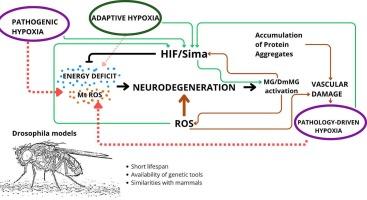Utility of Drosophila for studying hypoxia-inducible factor (HIF) in neurodegenerative diseases: Advantages versus limitations
IF 2.6
4区 医学
Q3 NEUROSCIENCES
引用次数: 0
Abstract
Hypoxia-inducible factor 1α (HIF-1α) plays a critical role in cellular responses to oxygen deprivation and is increasingly recognized as a key regulator in neurodegenerative diseases. Drosophila melanogaster serves as a powerful genetic model for investigating HIF-1α signaling, particularly through its homolog Sima. This review examines the advantages and limitations of using Drosophila to study HIF-1α in the context of neurodegeneration, with a focus on oxidative stress, autophagy, and mitochondrial dysfunction. We discuss the role of HIF-1α/Sima in modulating neuroprotective pathways, including its interactions with DJ-1 (also known as PARK7 Parkinson disease protein 7), SNCA (Alpha-synuclein), and the mTOR-autophagy axis. Moreover, we highlight the potential of Drosophila in elucidating hypoxia-mediated epigenetic modifications, non-coding RNA regulation, and metabolic adaptations relevant to neurodegenerative diseases. Understanding these mechanisms may provide insights into novel therapeutic approaches for the major neurodegenerative conditions in humans, such as Parkinson’s disease and Alzheimer’s disease.

果蝇在研究缺氧诱导因子(HIF)在神经退行性疾病中的应用:优势与局限性
缺氧诱导因子1α (HIF-1α)在细胞对缺氧的反应中起关键作用,并越来越被认为是神经退行性疾病的关键调节因子。黑腹果蝇(Drosophila melanogaster)是研究HIF-1α信号的一个强大的遗传模型,特别是通过其同源物Sima。本文综述了在神经退行性疾病背景下使用果蝇研究HIF-1α的优势和局限性,重点是氧化应激、自噬和线粒体功能障碍。我们讨论了HIF-1α/Sima在调节神经保护通路中的作用,包括它与DJ-1(也称为PARK7帕金森病蛋白7)、SNCA (α -突触核蛋白)和mtor自噬轴的相互作用。此外,我们强调了果蝇在阐明缺氧介导的表观遗传修饰、非编码RNA调控和与神经退行性疾病相关的代谢适应方面的潜力。了解这些机制可能为人类主要神经退行性疾病(如帕金森病和阿尔茨海默病)的新治疗方法提供见解。
本文章由计算机程序翻译,如有差异,请以英文原文为准。
求助全文
约1分钟内获得全文
求助全文
来源期刊

Brain Research
医学-神经科学
CiteScore
5.90
自引率
3.40%
发文量
268
审稿时长
47 days
期刊介绍:
An international multidisciplinary journal devoted to fundamental research in the brain sciences.
Brain Research publishes papers reporting interdisciplinary investigations of nervous system structure and function that are of general interest to the international community of neuroscientists. As is evident from the journals name, its scope is broad, ranging from cellular and molecular studies through systems neuroscience, cognition and disease. Invited reviews are also published; suggestions for and inquiries about potential reviews are welcomed.
With the appearance of the final issue of the 2011 subscription, Vol. 67/1-2 (24 June 2011), Brain Research Reviews has ceased publication as a distinct journal separate from Brain Research. Review articles accepted for Brain Research are now published in that journal.
 求助内容:
求助内容: 应助结果提醒方式:
应助结果提醒方式:


